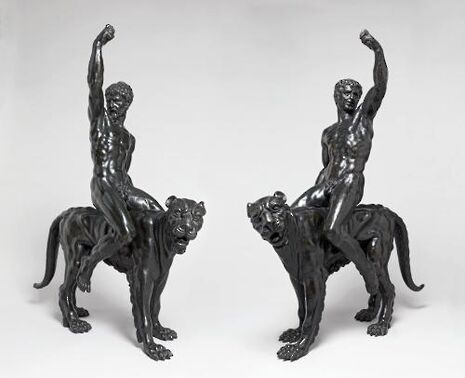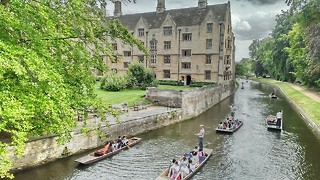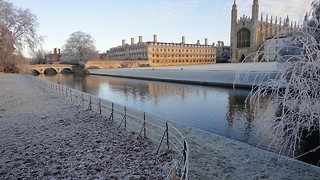A Michelangelo Discovery
Isabelle Kent gets the story on the Fitzwilliam Museum’s recent discovery from Professor Paul Joannides

Michelangelo is one of the most famous artists of all time. His name conjures in the mind’s eye the great marble nude of David and the iconic Creation of Adam. However ‘bronze’ is not a common association, at least not until now.
Walking into the Italian gallery in the Fitzwilliam Museum I am confronted by two raised bronzes depicting virile nudes, both mounted on panthers. They are bacchants, followers of the decadent wine god. Accompanying me is the internationally renowned authority on Michelangelo, and the man who has attributed these sculptures to the great artist, Professor Paul Joannides. The announcement of the discovery, made on the 1st February, has sparked international interest. If his attribution is accurate they would be the only surviving bronzes by the Renaissance master.
These Rothschild Bronzes, named for their former owner, Baron Adolphe de Rothschild, have had a turbulent past when it comes to attributions, so in 2013 Professor Joannides was asked to investigate them. “I was very surprised because the figures immediately seemed to me to be intensely Michelangelesque in a way which I had not, and have not, encountered in the work of any other 16th century sculptor.” He points to the lower arms, the way the wrists are bent and the hands clenched, much like Michelangelo’s David and some figures in the Sistine chapel. “The combination of expressive musculature, that anatomical mobility Michelangelo so much prized, and satisfyingly abstract form, placed these bronzes very close to Michelangelo – and at a specific period: his treatment of physical form becomes very different and broader in [the] next decade.”
An attribution to an artist such as Michelangelo is exceptionally risky, even more so in the case of these bronzes. Until 1878 the sculptures were completely unknown to the public, and no documented evidence has been found to suggest the nature of their commission. However Professor Joannides has managed to date the works very specifically to the period 1506-08. “Michelangelo studied the Laocoon [an ancient Roman sculptural group] immediately on its discovery in April 1506. Here the men’s movements, the arrangement of their arms and legs, the contrasting tensions of heads and torsos and legs, reflect elements of the Laocoon and I cannot conceive that they could have been done without knowledge of it,” he says.
Michelangelo’s interest in art of the antiquity was only rivalled by his obsession with anatomy; he is known to have been one of the few Renaissance artists allowed to dissect cadavers. “Professor Abrahams [the anatomist consulted by Joannides’ team] demonstrated that the men’s bodies are true to underlying anatomy as known through dissection.” He points to a muscle on the thigh, explaining how Michelangelo must have knowledge of it through dissection since it does not physically appear, even on the most herculean of men. “This manipulation of knowledge for his own purposes… is entirely characteristic of Michelangelo,” Joannides says.
The sculptures are highly enigmatic. Coming to just under a metre in height they are too large to be table ornaments and too small to work as monumental or niche sculptures. Joannides shakes his head when asked about their purpose. “I wish I knew. My hypothesis – which did not make it into our booklet – is that the felines had a double function: when their riders are removed, easily done, they work as bases for something else – perhaps flag-staffs or the poles of a baldachin, placed either side of a throne. This would also account for the animals’ symmetry. But I have been unable to find anything comparable, and friends who know much more than I do about the decorative arts have produced no examples; so it was thought best to omit my idea. However, it still seems to me – if to no-one else – the most economical explanation of the facts of removability and disjunction.”
Looking at the panthers it is easy to see how they could be stand alone sculptures. They are highly stylised, completely at odds with the classical nudes. “We should really have called them ‘indeterminate stylised felines’”, Joannides jokes. “They are energetically modelled but their relative simplicity of pose is surprising and must reflect their function. A couple of years before Michelangelo was drawing dynamic studies of fighting cavalrymen for the Battle of Cascina, in which men and horses are integrated in ways that Leonardo could not have bettered. If figures and mounts are here disjunctive, that was intentional.”
The only contemporary document that ties these bronzes to Michelangelo is the Musée Fabre facsimile drawing said to be a copy of one of the sculptors own ‘concetto’, a preliminary thumb-nail sketch. It depicts a nude male riding a panther, just like the bronzes, however the poses differ greatly. Joannides states “the concetto would have been followed by many more drawings and, probably, wax models. What is revealing in this drawing, and connects it unequivocally with the bronze groups, is the fact that the feline is so stylised, and that the figure is not integrated with it: i.e. that disjunction between rider and mount is inscribed from the start.”
It will be interesting to know how these bronzes may change the way Michelangelo is studied. Joannides nods, “I hope it shows that, even about Michelangelo, not everything has been said. We know that he sometimes made designs for the decorative arts – and these bronzes are essentially decorative – of which virtually nothing survives. And it may encourage more thought about interaction among forms and media in Michelangelo’s art: it is obvious that he is a sculptural painter, but less so that he could be a very painterly sculptor, or that his treatment of marble – especially his early years – is heavily indebted to prototypes in bronze. Finally, it may encourage people to look around Michelangelo. On the Musée Fabre page is a Virgin and Child extracted from a larger group; some years ago I stumbled across a painting to this design, plus St Joseph. Whether the painter had access to a more complete drawing, or whether he might have copied a lost painting by Michelangelo himself, is an open question. I suspect that there is still much to discover on the periphery of Michelangelo.”
The discovery of the bronzes has been picked up by news organisations the world over, and many are visiting the Fitzwilliam to see the works. Joannides smiles, “I’m astonished. Interest in Renaissance art is declining in museums, among collectors and, perhaps even, the public, with attention now directed to modern and contemporary art. However, I can only suppose that ‘Michelangelo’ still means something. Certainly, if people look at his work with an unprejudiced eye, they will find he has a great deal to offer.”
The Rothschild Bronzes are on display until August 2015. A Michelangelo Discovery is on sale in the Fitzwilliam shop.
 Comment / Anti-trans societies won’t make women safer14 November 2025
Comment / Anti-trans societies won’t make women safer14 November 2025 Features / Beyond the Pitt Club: The Cambridge secret societies you have never heard of16 November 2025
Features / Beyond the Pitt Club: The Cambridge secret societies you have never heard of16 November 2025 News / Controversial women’s society receives over £13,000 in donations14 November 2025
News / Controversial women’s society receives over £13,000 in donations14 November 2025 Fashion / You smell really boring 13 November 2025
Fashion / You smell really boring 13 November 2025 News / A matter of loaf and death17 November 2025
News / A matter of loaf and death17 November 2025








